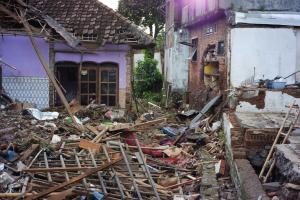
Strategies for Community Resilience After a Major Hurricane
Assessing Damage and Prioritizing Infrastructure Repairs
"Hurricanes leave widespread destruction that affects roads, utilities, homes, and businesses. Structural assessments determine which buildings require repair, reinforcement, or reconstruction," notes Carr Jr. Local governments and emergency management agencies coordinate efforts to restore critical infrastructure, including power grids, water treatment facilities, and transportation networks.
Mitigation strategies play a role in rebuilding efforts. Storm-resistant materials and updated construction techniques improve structural durability. Elevating buildings, reinforcing roofs, and implementing improved drainage systems help reduce damage in future storms.
Strengthening Flood Protection and Water Management
Flooding remains one of the most destructive effects of hurricanes. Coastal and low-lying communities prioritize flood mitigation efforts by upgrading levees, improving stormwater drainage, and implementing natural flood defenses such as wetlands restoration. These measures reduce long-term damage and help manage excess water during extreme weather events.
Property owners participate in flood mitigation by elevating homes, installing sump pumps, and using flood-resistant materials. Local officials assess floodplain maps and update zoning regulations to prevent future developments in high-risk areas.
Emergency Preparedness and Community Coordination
Strengthening emergency response capabilities ensures that communities respond more effectively to hurricanes. Disaster response plans include evacuation routes, emergency shelters, and communication systems that keep residents informed before, during, and after a storm.
Local emergency management agencies work with businesses, nonprofit organizations, and community leaders to distribute supplies, restore utilities, and coordinate volunteer efforts. Preparedness training programs, including first aid, search-and-rescue training, and disaster response simulations, help communities develop effective response strategies.
Protecting Critical Infrastructure and Utilities
Power outages and utility disruptions after a hurricane slow recovery efforts. Strengthening the electrical grid, reinforcing power lines, and implementing backup energy solutions improve resilience. Communities invest in microgrids, underground power lines, and renewable energy sources to reduce dependency on a centralized power system.
Telecommunications and internet infrastructure also require reinforcement. Emergency communication systems ensure that first responders, government agencies, and residents remain connected. Upgrading water treatment facilities, reinforcing dams, and improving waste management systems protect public health and environmental safety.
Economic Recovery and Business Continuity Planning
Hurricanes disrupt local economies, affecting businesses, supply chains, and employment. Small businesses and essential service providers develop business continuity plans that outline recovery strategies, alternative supply chains, and remote work capabilities.
Local governments and financial institutions provide economic relief programs, including low-interest recovery loans, tax incentives, and financial assistance for affected businesses. Workforce development programs support displaced workers and help rebuild local industries.
Insurance and Risk Management Considerations
Homeowners and businesses review insurance policies to ensure adequate coverage for future storms. Understanding policy terms, coverage limits, and deductibles allows property owners to make informed decisions about risk management.
Insurance companies assess damage and process claims efficiently to support rebuilding efforts. Local governments work with insurers to improve access to affordable flood and windstorm insurance. Strengthening building codes and implementing stricter zoning regulations reduce insurance risks and long-term costs.
Environmental Restoration and Coastal Protection
Coastal communities invest in environmental restoration projects that protect against storm surges and flooding. Wetlands restoration, dune reinforcement, and barrier island stabilization create natural storm defenses. These efforts reduce erosion, absorb floodwaters, and provide long-term environmental benefits.
Reforestation and green infrastructure projects improve water absorption and prevent soil erosion. Urban areas incorporate permeable pavement, rain gardens, and retention ponds to manage stormwater runoff. Sustainable land-use planning ensures that future developments prioritize disaster resilience.
Long-Term Housing and Community Redevelopment
Hurricanes displace residents and damage housing infrastructure. Community rebuilding efforts focus on constructing resilient homes, expanding affordable housing options, and implementing stricter building codes. Disaster-resistant housing initiatives provide long-term stability for affected families.
Local governments collaborate with housing agencies, nonprofit organizations, and construction firms to accelerate rebuilding efforts. Community redevelopment plans include mixed-use developments, walkable neighborhoods, and improved public transportation systems that support long-term resilience.
Lessons Learned and Future Preparedness Efforts
Every hurricane provides lessons for future preparedness. Emergency response agencies conduct post-disaster evaluations to assess strengths, identify weaknesses, and improve future response efforts. Data from previous storms inform new policies, building standards, and infrastructure investments.
Collaboration among federal, state, and local agencies ensures that communities receive the resources and support needed for long-term recovery. Strengthening disaster response coordination, improving early warning systems, and expanding public education efforts contribute to overall resilience.
Conclusion
Recovering from a major hurricane involves more than rebuilding structures. Strengthening infrastructure, improving flood management, enhancing emergency preparedness, and investing in environmental restoration create a foundation for long-term resilience. Communities that implement proactive mitigation strategies can reduce future disaster risks and improve their ability to recover from severe weather events.
Morgan Thomas
Rhino Digital, LLC
+1 504-875-5036
email us here
Visit us on social media:
Facebook
Distribution channels: Building & Construction Industry, Culture, Society & Lifestyle, Environment, Natural Disasters, Real Estate & Property Management
Legal Disclaimer:
EIN Presswire provides this news content "as is" without warranty of any kind. We do not accept any responsibility or liability for the accuracy, content, images, videos, licenses, completeness, legality, or reliability of the information contained in this article. If you have any complaints or copyright issues related to this article, kindly contact the author above.
Submit your press release

